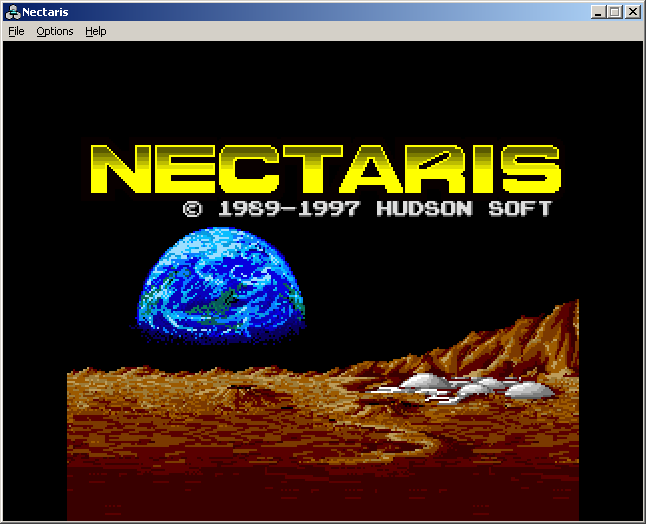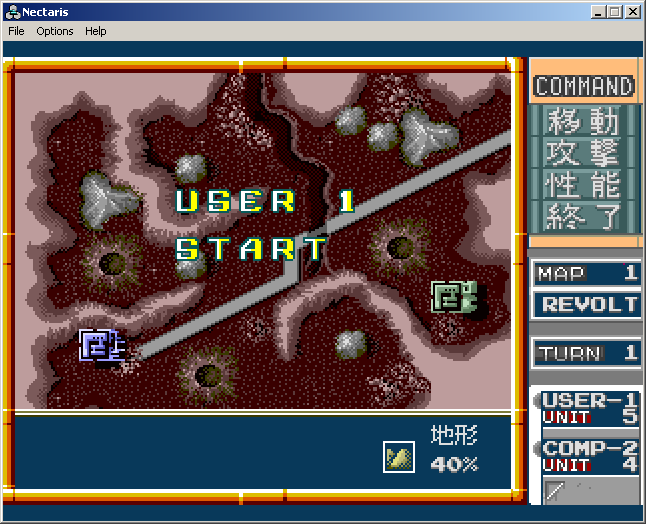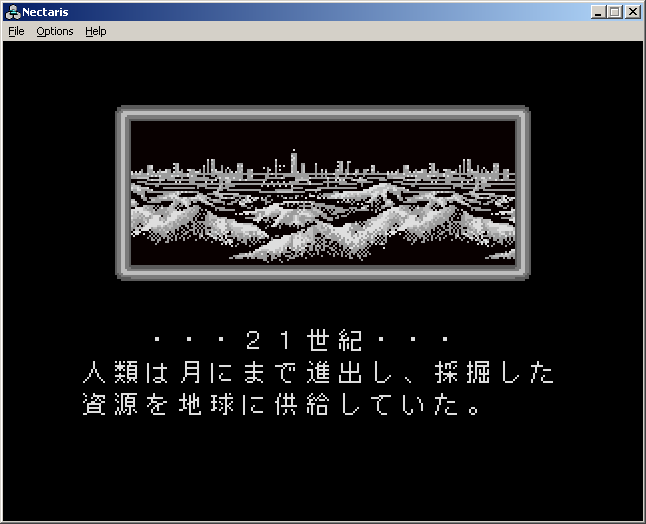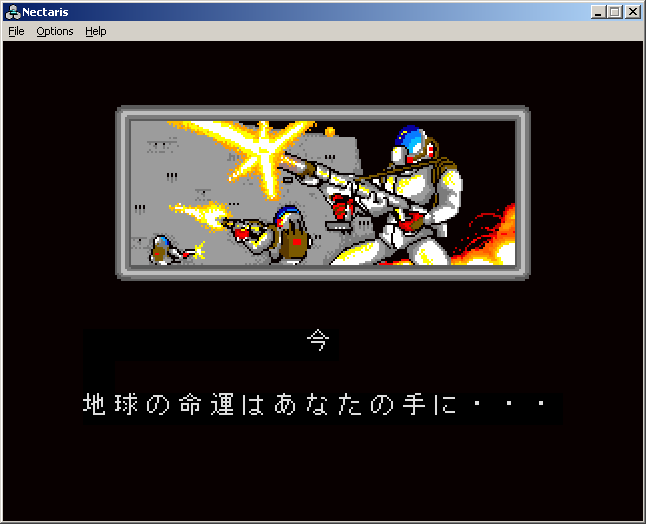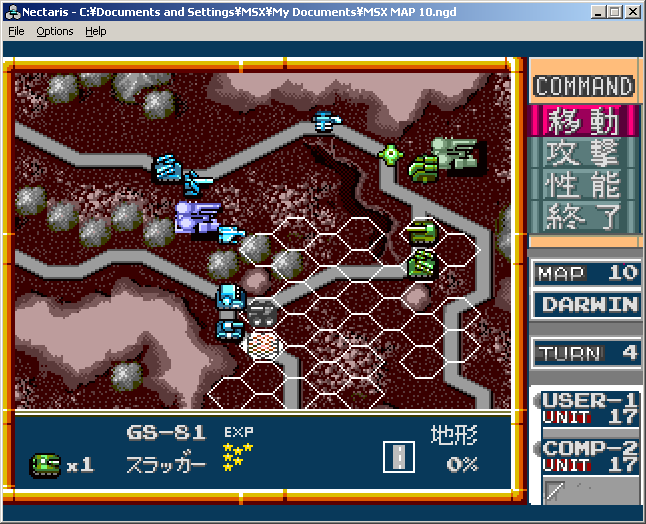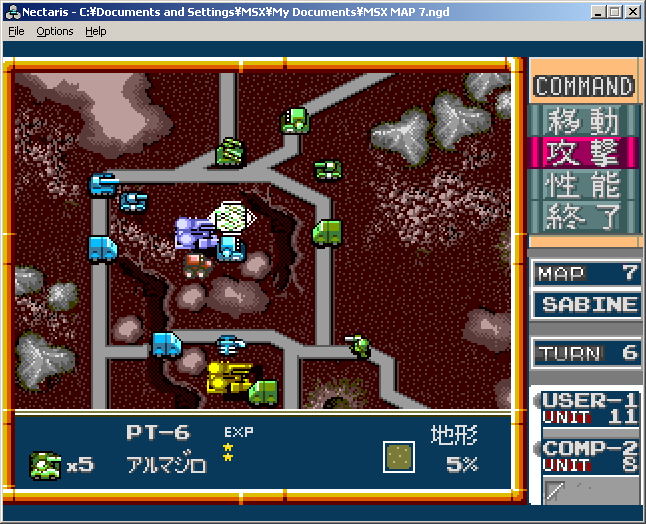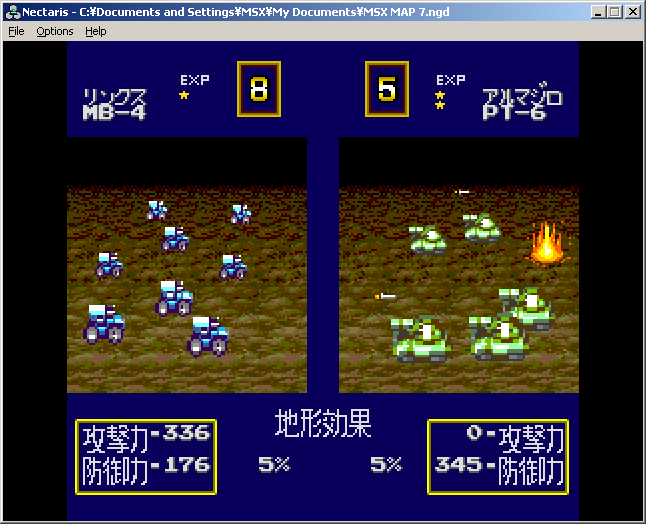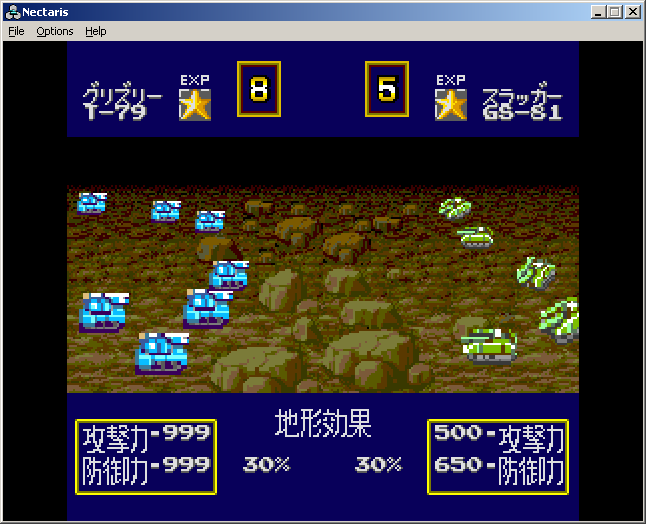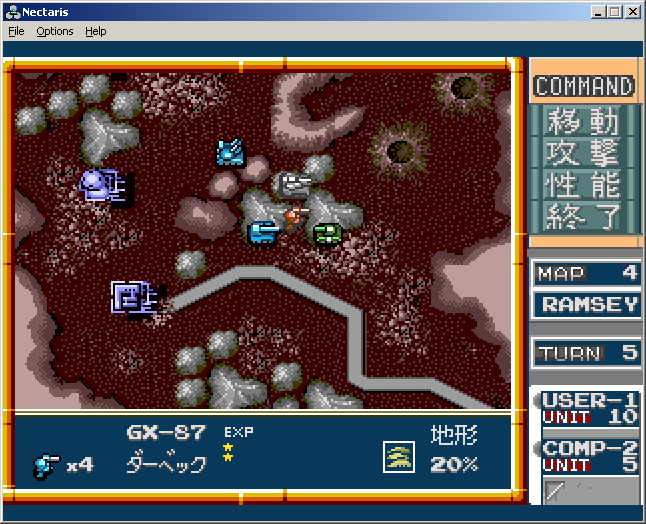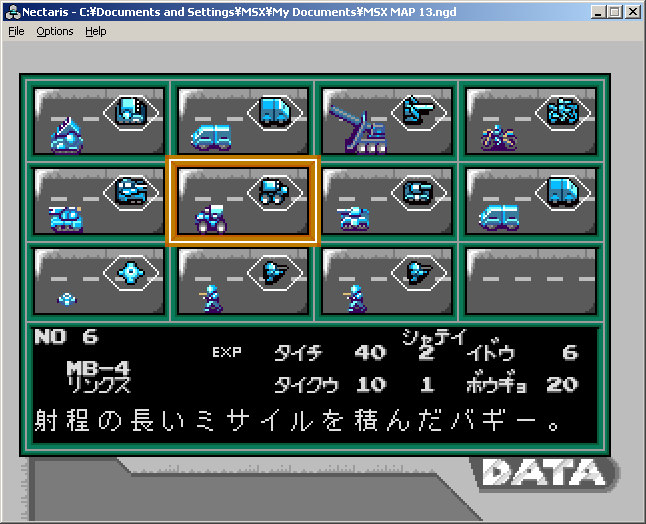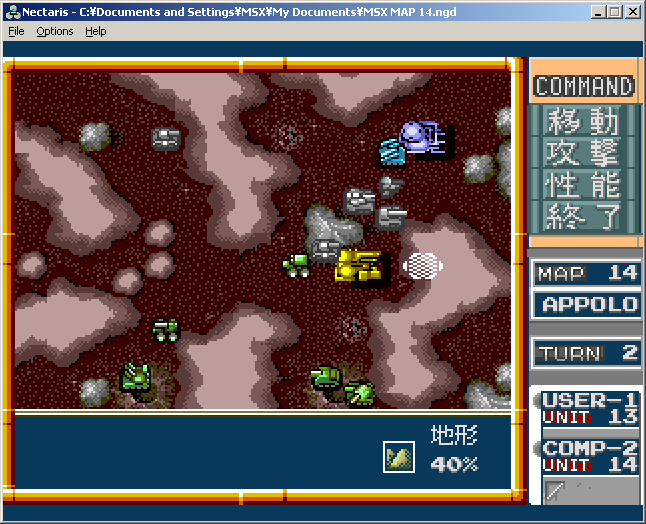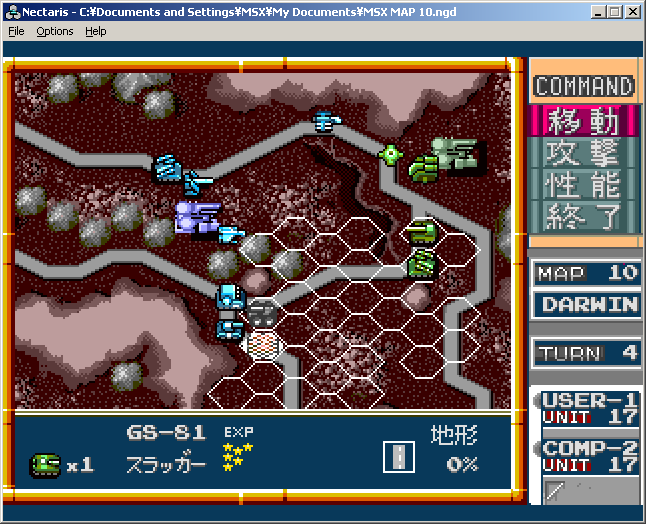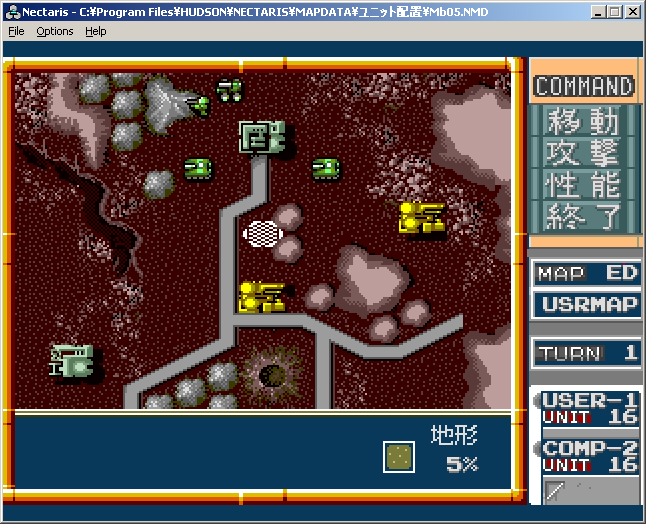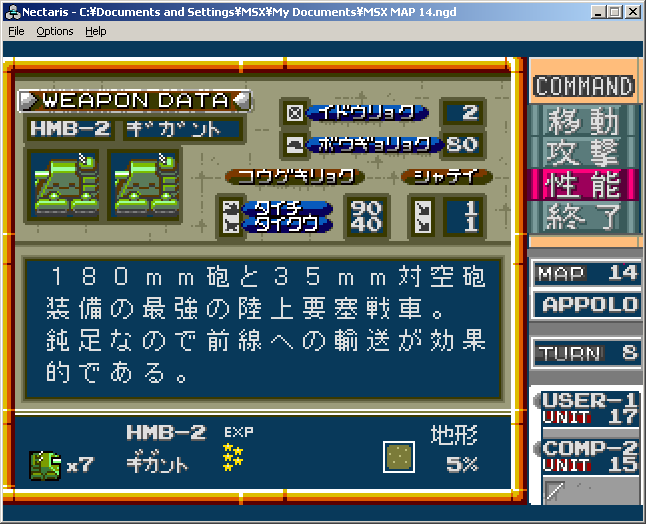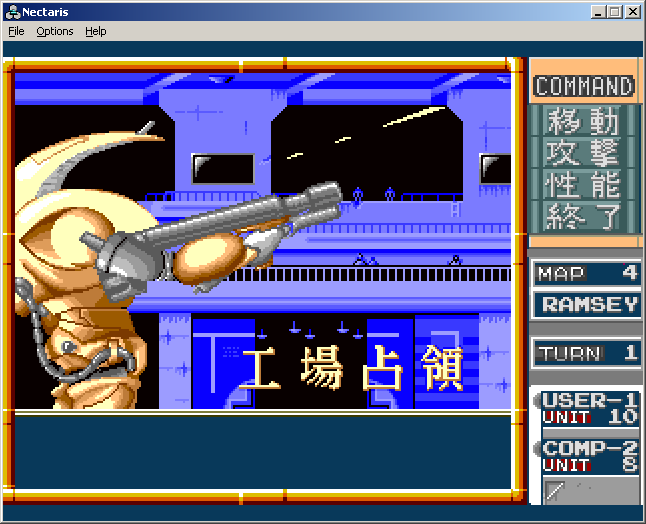Nectaris – Hudson Soft - 1997 - First time playing?: Yes!
One of my favourite things about retro PC games is the satisfaction of finding an obscure gem you didn’t even know existed that completely fell out of the public’s mind decades ago. With the wide selection of distribution methods and more readily available development tools, anyone can make a PC classic and release it on the web for anyone to play. Managing to find these is especially rewarding, and I have a particular fondness for Japanese freeware. Lord Monarch Online is one of my personal favourite finds, and now I can add Nectaris to that list.
Originating on the PC Engine, Nectaris, also known by the much more generic but pleasingly alliterative title Military Madness for its Western release, is a turn-based sci-fi strategy game and an absolute gem from that console’s library. Nectaris was no stranger to ports however, there were plenty of adaptations and remakes and reimaginings on platforms such as the Game Boy, PlayStation and plenty of digital platforms. The original is likely the most well known thanks to being the version emulated for the Wii Virtual Console release, but there's also a few unknown PC adaptations of the game. Japan got ports for the PC-98 and X68000, while Europe got a German developed DOS adaptation with new units and maps, which sounds like good material for a future review as well. The one we're looking at today however is the Windows 95 port, released in Japanese as freeware by Hudson in 1997. Later on the port was updated with a Windows 98 version, but I’ve been unable to find a download for that anywhere. Thankfully the Win95 version still works great on XP and even Windows 10, though the installer for the game itself does not due to being 16-bit. Check the end of the review for a download link to a preinstalled version if interested!
A hundred years into the future, humanity has taken to the stars and colonised the moon, rich in valuable resources that have since been drained from their Earth. With the introduction of new land however comes the inevitable conflict over who owns what, as even in the future humanity is no less self destructive, war crazed and violently power hungry. The Guicy Empire has dominated the moon, reducing all other settlements to prison camps in their conquest. With all of the resources of the moon at their disposal they are building their doomsday weapon, the MOA missile launcher, a devastating nuclear weapon that will guarantee the downfall of Earth should it be fired. Time is running out, and only one camp of the Union remains as opposition on the moon. To take back the moon and get to the Nectaris base in time to destroy the missiles will take tactical skill and using every one of your limited weapons available to you to their absolute maximum potential.
Beyond that intro, there is very little in the way of story here, but it's very effective in setting the tone. There's a dark and moody atmosphere to Nectaris as well as a sense of desperation, but alongside a sense of satisfaction as you see the overworld map between levels showing your progress and all the camps you have taken back one by one. A good setup for a satisfying strategic campaign where the gameplay is front and centre and absolutely shines.
In terms of gameplay, Nectaris manages a simple and understandable UI and controls while still having plenty of variables and unique units resulting in a huge amount of tactical consideration that is an absolute joy. Alongside Advance Wars, Nectaris is one of the most gentle introductions to turn-based strategy games while still demonstrating what makes the genre such a satisfying blast. It’s common for games that simplify their mechanics either for console controllers or for wider mass appeal often lose part of the appeal of the kinds of games being simplified, but that’s not an issue with Nectaris. With a two-button controller and the only commands given to your units being “move” and “attack”, Nectaris still captures everything I’d consider integral to the genre while also having the depth to engage more experienced TBS fans.
Maps range in size from single screen arenas to larger scrolling battlefields made up of hexagonal tiles, where the Union and Guicy Empire take turns commanding all of their units, moving them across the game board and choosing what enemy units they wish to attack. You can move as many or as few of your units as you want in a single turn, but they can only attack once per turn each and are limited in how far they can move in a single turn by their movement stat. Each unit consists of an armada of eight identical vehicles, though more and more of those individual vehicles will be destroyed as they enter more skirmishes. The less vehicles your unit has left, the less damage you do and the lower your defence is, however your destroyed vehicles can be repaired by taking their unit to a factory. Factories contain a finite amount of units that you can send out at any time during your turn, while also allowing you to store your units already on the map in them, both for the repairs mentioned earlier but also for keeping them safe from attackers. Most factories are neutral, signified by them being coloured yellow, and you must have one of your infantry units reach a factory to liberate it and have its units join the Union, but if a Guicy unit claims them first then they’ll be enslaved into their side. Of course, there’s always the possibility of stealing the factory back from them, though they tend to defensively swarm their factories with units if you're near which can make things difficult. There’s two ways to win a map in Nectaris, either by destroying every enemy unit or taking control of the enemy’s camp with an infantry unit. The latter is quicker but risky as a result of infantry units being very weak and the camp being right in the middle of enemy territory. Meanwhile, if you lose all your units or lose your camp, or if the battle goes on for more than 50 turns, you lose the map and will be forced to start again. Don’t worry about the turn limit though, I never came close to it in any of the normal maps.
When moving one of your units to attack an enemy unit, the game will go into a side-on view that shows the two units battling it out. The outcome of this battle is determined by a wide array of variables that can be exploited to overpower the Guicy Empire. First off, there’s your unit’s stats. Every unit has two attack stats, one for ground combat and one for air combat. The higher the stat, the more damage they do to units of that type. If a unit has a stat of 0 in either of those attack stats, that means that unit can’t attack other units of that type. Units also have a defence stat, just a single stat that covers defence against all attacks. The higher that stat is, the less damage that unit takes from enemy fire. Finally, there’s range. Ranged units can hit enemy units from a distance, allowing you to attack them without getting countered and potentially losing some of your own vehicles. This is ideal if it’s an available option, however there are some limitations to prevent them becoming too overpowered. First off, ranged units can not move and attack in the same turn, they can only do one or the other, so if no enemy units aren’t in range then you can only move the unit and have to wait until the next turn for another chance for them to be able to attack. Secondly, they can’t attack enemies at a melee range, so if an enemy has a tank on a hexagonal tile right next to your ranged unit then that ranged unit is a sitting duck unable to defend itself. Determining what units are most viable against enemy units and checking the stats and attack range to ensure you’re safe before acting and ending a turn are both integral to success.
Choosing the right units for the right combat scenarios is a major part of the strategy, but there’s actually plenty more variables that also modify those attack and defence stats. First off, as your units survive more skirmishes, they gain more experience, represented by stars next to the unit’s name. The more experience a unit has, the more its stats raise, maxing out at 9 stars. This helps ensure that even as your unit loses vehicles in combat, the experience gained from battle will raise your defence and offence. By the time you reach 9 stars you’ll likely only have a couple of units left, but taking them back to the factory for repairs allows you to keep the experience, but now with a full armada of eight vehicles. Secondly, terrain makes a huge difference as well. Rocky terrain offers more cover, and as such enemies hiding behind mountains will have higher defence than those out in the open on the middle of a flat road. Terrain also impacts movement, certain units will not be able to traverse certain terrain types, while others will simply be slowed down by it instead, not being able to move as far in a single turn. Finally, units surrounded by ally units will have their stats boosted, while units surrounded by enemy units will have their stats lowered, allowing you to play both defensively and offensively by keeping your units close. However, keeping all units together prevents you from taking control over the full map by spreading out and claiming multiple factories, requiring a balance between the two play styles.
So between the units, the terrain, experience and the bonus stat boosts when keeping units close together there’s a lot to be considered here as you decide your course of action. The map itself is just as important as the enemy unit formations, with both being able to be exploited to your benefit. This may sound overwhelming, but the game has a gentle difficulty curve that prevents you from feeling thrown into the deep end. Other strategy games from this era can be an uphill battle to get into, with complex rules that can only be understood by reading the manual alongside massive scale maps and confusing interfaces. Nectaris has held up exceptionally well in this regard with its simple controls, easy to use interface and its gradual introduction of new mechanics. At the start of the game you’ll only have access to two different units, there’s no factories and the map is only a single screen in size. Then a little later on new unit types will be introduced, later maps expand in size, there’s more factories to claim and then by the second half of the game it’s testing you in all you learnt from that buildup. Something that has the potential to be unbalanced but actually works incredibly well is that the Guicy Empire tends to get access to new mechanics before the Union does. For instance, the first map that has a factory in it only has one which the Guicy Empire has already claimed. This means that you can see how the CPU uses these new elements in question and gain an understanding of how they work before you’re given access to them in the next map. Nectaris’ smooth difficulty curve simply can not be praised enough, it’s incredible how well this game’s accessibility and user friendliness has held up, even in spite of the original game being released all the way back in 1989. Famicom Wars did a lot similar to Nectaris and came out a year earlier, but other aspects didn’t show up in the Nintendo Wars series until long after Nectaris had been released. It’s clear that both games had a significant role in the development of the turn-based strategy genre on consoles.
Once you get deeper into the campaign, the sheer variety of units is really the highlight here in Nectaris. Many of the vehicles are named after animals which makes them easy to remember as their utility often reflects the animal name in question. For instance, you have the Rabbit, a lightly armoured moon buggy that is incredibly fast and can hit pretty hard while also being one of two units that can move after attacking as well as beforehand, but has extremely low defence that puts it at risk if you have them in the frontlines. Ranged cannons tend to get named after horned animals, such as the Nashorn (German for rhino) which has good range and good attack power for land vehicles, and then you have the Monoceros (Greek for unicorn) which has even better range and devastating attack power, with the caveat that they can’t be moved after you’ve placed them on the map. You can carry Monoceros to good spots by using the Mules, convoys that are lightly armoured and have weak weaponry but good movement speed, or you could carry them with the Pelican, a carrier aircraft that is much faster but has absolutely no weaponry as a tradeoff. You have the Falco, a fighter plane with incredible damage output but no ability to attack ground-based enemies, leaving them extremely vulnerable to the Hawkeye, an anti-air cannon. Hunters are fighter planes that can attack ground enemies but at the cost of their air attack, leaving them vulnerable to Falcos, while the Jabby is a bomber plane that can decimate land-based units, even anti-air units, but is a glass cannon that can easily be swiftly destroyed by both the Falco and Hunter. Gigants are heavily armoured battle tanks with brutally high attack strength for both ground and land units in addition to ridiculously high defence, but they can only attack at melee range and have extremely slow movement speed, leaving them vulnerable to ranged attackers. One in particular that can do a good job at chipping away at Gigants is the Lynx, a moon buggy similar to the Rabbit with similar high speed and low defence, with the primary difference being that it can attack from a range of two hex tiles, allowing you to rush in, get a few shots in on the Gigant and then flee out of their movement range, thanks to Lynxes being the other unit that can move after attacking like the Rabbit.
I could go on for ages about each and every unit, but this gives you an outline of what you can expect. Every single unit is like this, having a potentially devastating strength that comes at a cost that leaves it vulnerable to a superior tactician. The one potential issue that you can run into is that since there’s no way to produce new units, if all of your units that can attack ground targets are destroyed you could be left with only anti-air units completely unusable against the enemy’s tank battalion. This happened to me in one map, but even from this I was able to recover. I used Falcos and Hawkeyes to create blockades to slow down the movement of enemy units just long enough to have a Pelican carrying infantry units sneak behind the Guicy army and take the camp to win the map. Even in a frustrating situation, finding a solution remained as satisfying as ever.
So Nectaris is a classic, full stop. But all of this applies to the PC Engine version as well. So what’s new in this Windows port? Quite a lot actually. The biggest draw for me personally is the ability to play with mouse controls. Using a mouse always feels most natural to me for these kinds of turn-based strategy games and it's implemented wonderfully here. As the game was already designed for gamepads with only two buttons, those can easily be mapped to the left and right buttons on a computer mouse, while your in-game cursor can be controlled by moving the mouse itself. This port also introduces a save system, allowing you to create a save file at any point you have control in the middle of any map, whereas in the PC Engine original you only had password saves which you could only get at the start of each map. Since the game wasn’t really designed around mid-level saving I chose to ignore this mechanic personally beyond just saving at the start of every map so I didn’t have to remember password names, but it’s absolutely going to make the game less intimidating for a lot of people who dread the thought of spending tens of minutes on a single map only to lose in the end. The soundtrack has also been redone in PC midi format, which isn’t going to be to everyone’s tastes but I personally enjoyed a ton, they did a very good job adapting the soundtrack here and I appreciate it giving a different more inherently Windows kinda feel as opposed to the PC Engine’s original chiptunes. There is a slight pause every time the game has to load a new midi file however that’s a bit annoying.
Perhaps the biggest addition however is the presence of a map editor called UNITEDIT. Cool as it is that it’s here, it’s unfortunately pretty weak. It doesn’t let you actually edit the map’s terrain, only allowing you to place units onto one of a selection of unitless template maps provided by the game. The game does however include nine extra pre-made custom maps for you to play, on top of the already existing 16 map long campaign. All levels from the PC Engine original are here, alongside the hard mode variants of all of them for a total of 41 maps to play. There’s user-made maps out there too if you’re able to search some Japanese fan sites for them, offering more content for those who want it. Apparently there’s also some fan-made level editors that let you edit the terrain too, however I’ve been unable to find them. The biggest disappointment with this port is the lack of a 2 player mode, which was present in the PC Engine original but is not available as an option on the main menu here regrettably. Regardless, for single player usage alone, this is a wonderful way to experience Nectaris.
There is the matter of the Windows port only being released in Japanese, which is a shame because if not for the language barrier this could have been the most accessible version of this game. You may decide it’s better to just play Military Madness on the Turbografx-16 instead so that you can play Nectaris in English, but as someone who doesn’t know a ton of Japanese and had only previously played a couple of levels of Military Madness max, I was surprised by how easily accessible I found this game. If you know hiragana and katakana and want to challenge yourself, you know enough to beat this game. Just use a dictionary to translate the unit stats and learn which of those options on the right side of the screen are “move” and “attack” and you’re good to go. You can also always cross-reference with Military Madness guides if need be.
As the game’s installer doesn’t work on Windows 10 and the installer itself is also hard to find already, I created a zip file including the game pre-installed for anyone wanting to try it that doesn’t have access to an old 32 bit Windows computer, alongside a read me to help people who don’t know Japanese get started and some custom maps found on the Japanese fansite Base Nectaris. The download is available here. If anyone reading finds any leads on the Windows 98 version of Nectaris or the fan-made level editors, please let me know! I’d love to see more of this get preserved as it’s a wonderful version of a wonderful game.
- Page written by MSX_POCKY, 13th May 2023
